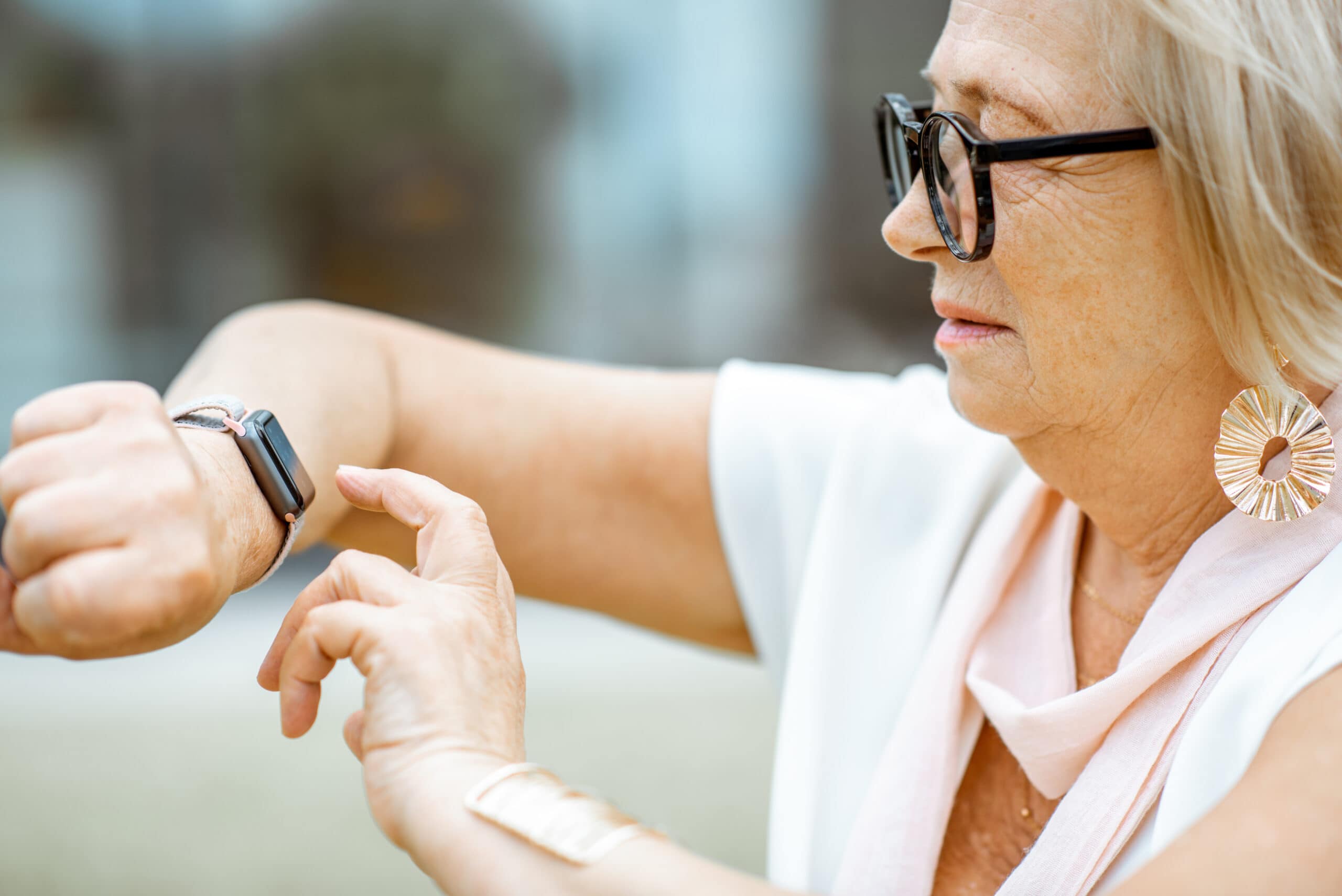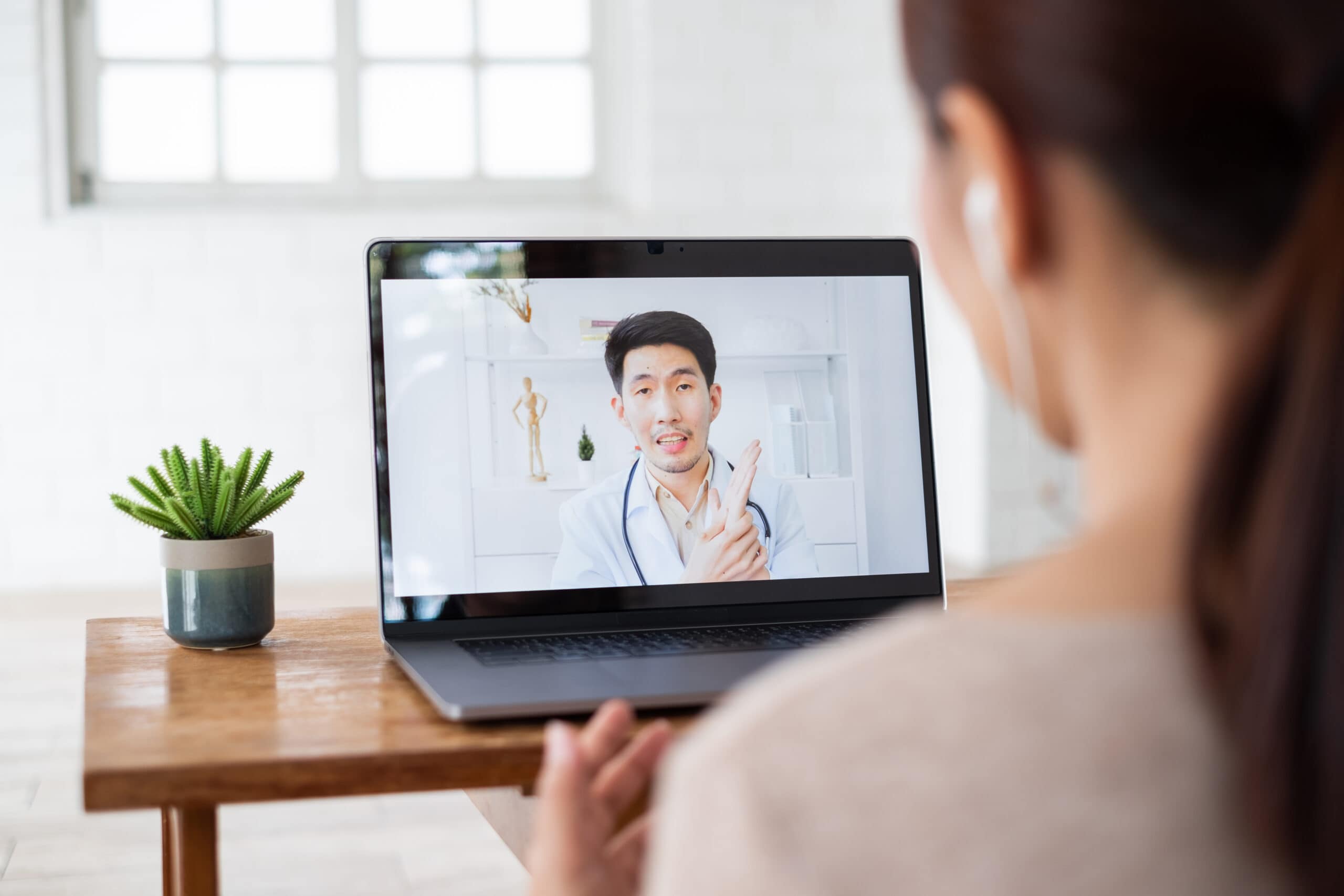Aging in the digital age: seniors and smart devices
Use of digital and other tech devices is commonplace among younger adults, but less so among seniors. However, this reality is changing, and largely due to the broad embracement of “Smart” devices. According to the Pew Research Center, 61% of adults aged 65 and older now own a Smartphone. While this is in comparison to 95% of adults aged 30-49 (plus 83% aged 50-64) the gap between Smartphone adoption among younger adults and seniors is rapidly shrinking. There are now actually a tremendous variety of “Smart” devices that can make life easier and safer for senior-aged adults. The following describes four of the categories of “Smart” devices that can be especially helpful to seniors in their daily lives.
Voice-activated digital and tech-driven devices
The ability to voice-activate digital devices can be a crucial aid for seniors, due to age-related health conditions that can limit finger dexterity or mobility. From turning on the overhead lights in the morning to unlocking the front door, voice-activated “Smart” devices such as Alexa and Google Assistant – paired with a Smart Home gadget – can simplify routine daily tasks. Six other tasks that this type of voice-activated device can do are:
- Let the device user know the day’s weather forecast;
- Turn on (and off) a coffee-maker, microwave oven, or robotic vacuum cleaner;
- Adjust the thermostats in the home to align with the desired temperature;
- Play selected music or an audio book;
- Add a food item to a digital list of groceries to purchase at a supermarket;
- Remind the user of a daily task to be performed such as picking up prescription medications from the drugstore
Around 47% of all adults aged 65 and older have diagnosed osteoarthritis (OA). Meanwhile, nearly 26% of senior-aged people have hand/finger OA. Therefore, voice-activated “Smart” devices can enable seniors living with OA to perform activities that would otherwise be far more difficult, if not impossible.
“Smart” medical alert systems
Medical alert systems that automatically dial 9-1-1, request an ambulance, and/or contact a patient’s doctor can be life-savers for senior-aged people. Three-fourths of all strokes occur in adults aged 65 and older, per a medical research article published in Aging. Without fast treatment, even a mild stroke can result in paralysis. Likewise, heart attacks require immediate medical intervention. For diabetics, a sudden spike in blood sugar level can necessitate obtaining an insulin injection to prevent slipping into a diabetic coma.
While medical alert systems – that paired a device similar to a landline telephone with a wristband (or neck pendant) containing an activation “button” – have existed since the 1980s, “Smart” alert systems now exist on most cell phones and many other types of digital devices.
Medication reminder and dispensing systems
It can be hard to remember to take a prescribed pill at any age, and this is particularly so for senior-aged adults. One reason that remembering to take prescribed medications can be more difficult for seniors is that adults aged 65 and older tend to take more daily pills than younger adults. More than half of all senior-aged adults take at least five daily prescription drugs. Telling those pills apart can be hard, and especially in elderly people with worsening eyesight or early Alzheimer’s disease. In turn, this can lead to a mix-up of taking too many pills each day of one prescribed medication and not enough of another.
While a medication reminder can be provided utilizing various “Smart” devices (such as a Smartphone), there are far fewer that can dispense the medications. The Ōmcare Home Health Hub® is one of those “Smart” devices that can dispense medications, as well as provide a reminder to take them.
“Smart” fitness trackers
Engaging in regular daily exercise is important for overall health, and this can be vital in senior-aged people to prevent heart disease. Notably, daily exercise has been found to ward off cognitive decline (such as short-term memory loss) in older-aged people. Mechanical devices such as pedometers have long been recommended to track steps per day.
However – ever since the first Fitbit was marketed to the public in 2009 – there has been an explosion in the availability of “Smart” fitness trackers. Not only have these been used by people (including senior-aged adults) while engaging in fitness activities, but they also have enabled their users to monitor heart rate, respiration rate, and blood pressure.
Overall, utilizing a “Smart” device can assist seniors in maintaining their personal independence, as well as boosting the likelihood of preserving health. Thus, this type of device can aid in reducing the likelihood of developing a preventable disability. By choosing the Omcare Home Health Hub, you can access its diverse capabilities that would otherwise require owning many different “Smart” devices.
The rise and fall of healthcare trends since the pandemic
Trends in healthcare are constantly changing to adapt to hospital, physician, and patient needs. The Covid-19 pandemic necessitated new ways of delivering patient care that reduced the likelihood of infecting clinicians and patients. Meanwhile, technological advances enabled the development of more collaborative approaches by physician teams to treat patients. However, no change happened so quickly and dramatically as the shift toward providing online “telehealth” services to patients (per a medical research article in 2020). The following describes three rising healthcare trends since the onset of Covid-19, and three healthcare system “norms” that are fading away.
Three rising trends in healthcare delivery to patients
- Increased adoption of team-based approaches to providing patient care:
The high cost of treating chronic disorders such as heart disease, Diabetes Type 2, and asthma has led public health leaders to promote healthcare provider team-based approaches to care. Likewise, the health complications commonly found in hospitalized Covid-19 patients after their discharge required more collaborative efforts.
For example, kidney damage was found in at least 30% of people hospitalized due to Covid-19. Without long-term physician care, daily medications, and dietary changes, people with kidney damage can progress to the life-threatening disorder of kidney failure. By enabling collaboration between primary care doctors (PCPs), specialist physicians, mental health therapists, and nutritionists, a post-hospitalization care approach for recovered Covid-19 patients with kidney damage could be quickly developed and implemented.
Videoconferencing software linking networks of healthcare providers boosted the capacity for healthcare teams to collaborate more efficiently. This continues to enable increased collaborative efforts, and is a rapidly-growing nationwide trend.
- Providing “telehealth” patient care as opposed to requiring a doctor’s office visit:
The use of videoconferencing software and digital solutions has exploded since the onset of the Covid-19 pandemic. Besides enabling people diagnosed with Covid-19 to interact with their healthcare providers without infecting them, telehealth visits also enabled outpatient clinicians to provide help each day to more patients. This was because there was no need to clean and re-stock an exam room for each new patient, since the interactions were conducted online. In addition, it eliminated the necessity for patients to travel to the healthcare provider’s office to receive care.
Elderly patients tend to have an especially difficult time in finding a way to travel to a healthcare provider’s office. Many people aged 70 and older either no longer drive or are unable to use public transportation to reach their healthcare provider’s office. This is especially problematic for seniors without any adult children living close to them, or who have physical disabilities that limit walking.
The huge advantage of “virtual” office visits is that it enables people to receive care from their clinicians without leaving home. Consequently, this has led to an expansion in the capacity of “virtual” technological solutions to deliver healthcare to patients. Not only have healthcare providers and patients embraced “virtual” visits since the onset of the Covid-19 pandemic, mental health therapists are hopping on the bandwagon in large numbers.
- The use of robotic devices to perform surgery:
While the first robotic device used to perform surgery was FDA-approved in the early 2000s, advances in robotic device mechanisms have led to increased usage of robotic devices to perform surgeries. This is especially the case for surgeries requiring finger dexterity beyond that normally possible for the human hand. Outside of use by the military in field hospitals, FDA-approved surgical robotic devices are most often utilized in hospital operating rooms to assist in performing minimally-invasive (laparoscopic) procedures. For example, in 2021, the Hominis Surgical System was approved by the FDA to perform transvaginal hysterectomies.
The use of robotic devices to perform surgical procedures has enabled surgeries to occur with just the presence of a surgeon and one or two assistants, rather than numerous Operating Room (OR) staff members. Therefore, the daily scheduling of more minimally-invasive surgeries per day by hospitals is possible. Due to its revenue-boosting potential, use of robotic devices to perform surgeries is an increasing trend that we imagine will only continue to rise.
Three falling (and disappearing) trends
- Short waiting times in hospital Emergency Rooms (ERs):
Healthcare staff “burn-out” is contributing to fewer personnel to assist patients who walk into a hospital Emergency Room (ER), rather than arriving in an ambulance. However, another reason waiting times are lengthening is that an increasing number of community hospitals are closing, with more people seeking ER care at the remaining hospitals.
- Manual healthcare billing systems:
Billing systems used in physician group practices that send out invoices manually are going the way of the dinosaur. In their place, technologically-driven systems, that can quickly identify correct billing codes and spot billing errors, are becoming a standard practice.
- Rapidly finding an available bed in a nursing home when needed:
Since 2016, more than 500 nursing homes have closed, and many more plan to do so. A chief reason specified by nursing home owners is that they simply cannot afford to stay in business. Meanwhile – as a consequence of the Covid-19 pandemic – it has also been harder for nursing homes to find and hire new nursing aides willing to work for low pay while risking a Covid-19 infection. Since a minimum staff-to-patient ratio is required by state governments, nursing homes cannot accept more patients than they have nursing aides on staff to care for them. Therefore, finding an available nursing home bed to take your elderly family member who can no longer safely live at home is taking far longer than in the past.
These are just some of the changed trends currently occurring across our healthcare system. Advances in Artificial Intelligence (AI) medical research, the development of mRNA cancer treatments, and the continuing shift toward value-based payments by both Medicare and private insurers are other trends that are gathering steam.
Among its numerous capabilities, the Ōmcare Home Health Hub® can enable you to engage in virtual healthcare visits as well as appointment/medication reminders and medication dispensing allowing home to be the site of care.
Employee Spotlight: Wendy Mizutani
Name: Wendy Mizutani
Title: Vice President of Customer Care and Operations
Education: Master’s of Arts in Leadership, Augsburg University (graduating May 2024), Bachelor’s of Arts in Diplomacy and World Affairs, Occidental College
Time at Ōmcare: 4 Months (also 4 months end of 2019 and beginning of 2020)
One personal fact about you: My happy place is our family cabin in the mountains of Northern California.
1. What led you to Ōmcare?
When changing careers in 2019, I knew that I wanted to join the healthcare industry. In particular, I have a passion for helping people live independently as long as possible, based on my experiences as a caregiver for my mom. I met Lisa through a mutual connection and was inspired by Ōmcare’s mission of changing the way the world cares and addressing un-met needs for the growing population of adults 65+.
2. What’s the most rewarding part of working at Ōmcare?
Hearing from Hub owners, potential owners, and caregivers how Ōmcare simplifies their lives or takes a worry off their very full plate.
3. What is your favorite current project you’re working on?
I love working with the team to help deliver a product our customers will love and building a team of customer care professionals who share a passion to help.
4. Pick out a core value that means a lot to you. How have you seen this lived out in your time at Ōmcare?
We are a team. We understand the lifting power of many wings can achieve twice as much as any bird flying alone. Quite simply, there are no swim lanes or silos at Ōmcare. We’re here to help each other and everyone’s voice and contribution matter.
5. What are you most proud of accomplishing throughout your time at Ōmcare?
I really love the brand identity work that we’ve done with Marketing – it’s how we want to show up not only for our customers but for each other. It aligns with our values and mission and will become the way that we measure success and the quality of our customer service.
6. Why should someone work at Ōmcare?
Ōmcare is a company dedicated to making a real difference in the lives of our customers and their loved ones. Working for a company with clarity on their purpose matters and doing it with people who share that passion is invigorating. Ōmcare is a place where you can grow your skills and be valued for your experience, opinions, and hard work.
Is technology the cure for the loneliness epidemic?
Senior-aged adults experienced a loneliness surge during the height of the Covid-19 pandemic. Yet, even before the pandemic, 40% of adults over age 65 reported feeling lonely. This makes sense when we consider that social isolation is a major cause of loneliness in senior-aged adults. Despite fewer Covid-19 hospitalizations, the Covid-induced increase in social isolation continues to persist among senior-aged adults. Technology use was embraced by many seniors during the pandemic mainly due to its capacity to enable online interpersonal connections. Medical research findings published in 2022 confirmed this increased Internet and digital device utilization among the elderly due to the Covid-19 pandemic.
The causes of senior-aged social isolation
Nearly four in 10 senior-aged adults live with extended family worldwide. However, those in the US rarely do. As of 2020, 28% of community-dwelling seniors lived alone. While death of a spouse or dementia in a spouse are major reasons for increased social isolation among older-aged adults, an increased amount of disability and death among longstanding friends is another cause. The following are four other causal factors:
- Relocation by adult children to a new residence far from their senior-aged parents;
- Worsened eyesight, leading to reduced driving to engage in social interactions;
- Chronic health disorders and physical disabilities that limit visiting family and friends;
- Higher risk to contract an infection resulting from large social gatherings.
At least 50% of adults aged 60 or older are at risk for social isolation, with 33% expected to experience a high degree of loneliness in future, per a recent article in BMC Public Health. In turn, this reveals that a loneliness epidemic in senior-aged adults requires immediate attention.
The link between loneliness, depression, and chronic health disorders
Loneliness can lead to chronic depression in both younger and older adults. However, chronic depression in seniors is also strongly-linked to the development of the following chronic health disorders:
- High blood pressure;
- Heart disorders such as arrhythmia;
- Obesity;
- Alzheimer’s disease and other dementias
According to the National Institute of Mental Health, chronic depression also increases the risk for chronic pain. In addition, it increases the risk for sleep disorders such as insomnia. Notably, sleep disorders are linked to an increased risk for depression and numerous chronic health conditions. Most of all, chronic depression and sleep disorders both tend to lessen the brain’s release of certain biochemicals – such as Serotonin – that boost mood and stave off depression.
Mental health benefits of technology utilization in the elderly
At 70 years of age, two out of three adults in the US have some level of cognitive impairment, most commonly short-term memory deficits and worsened reflexes. Overall, mental health is worsened by cognitive impairments (such as decreased problem-solving capacity). Since chronic depression as well as diverse chronic health disorders can foster increased cognitive impairments, engaging in digital “brain health” activities in can be beneficial for preserving cognitive functioning.
Brain plasticity & technology use
Brain plasticity—meaning the capacity for creating new nerve pathways in the brain—boosts cognitive ability and overall brain health. While younger brains have a higher degree of brain plasticity, findings published in Frontiers in Aging Neuroscience have shown that the elderly can also boost their brain plasticity. This is a particular reason that learning new information and skills (such as the use of tech gadgets) is especially beneficial for the mental health of senior-aged adults.
Additionally, continuous learning activities have been clinically recognized as protective of cognitive functioning in senior-aged adults. Therefore, learning new technology programs and digital devices can aid elderly individuals to both preserve their level of cognitive function, as well as interrupt further cognitive decline.
How technology can address the loneliness epidemic
While technology by itself cannot “cure” the loneliness epidemic, it can certainly help. Senior quality-of-life can be improved by interacting with others via technological approaches, which can boost both mental/emotional well-being and overall health.
Videoconferencing programs and social media have enabled interpersonal communication to continue among adults living with disabilities that limit their capacity to attend “in-person” social activities. This is especially the case for disabled senior-aged people who can no longer venture far from home. In this way, technology utilization can both lessen social isolation and loneliness – thereby reducing the likelihood of worsened mental health and physical health.
Ōmcare not only serves as a medication reminder and telehealth interface, but it also connects seniors to loved ones with the simple touch of a button. To learn more about how we’re bringing health and connection into the home, visit omcare.com.
Why medication adherence is important and how to improve it
Most adults with chronic health disorders are treated with medication, vitamins and minerals, or hormones. However, 50% of adults in the US living with chronic disorders do not take their daily medication (or other self-administered oral or IV therapies) as prescribed. According to a research article in The Permanente Journal, this results each year in around 100,000 preventable deaths and $100 B in preventable healthcare costs. Forgetfulness is not the only reason that medication nonadherence is so widespread, but this is a particular problem for the homebound elderly. Besides leading to worsened health status, not taking medication as prescribed is contributing to a worldwide public health problem.
Impact of antibiotic nonadherence and drug-resistant infections
The diagnosis of a skin, urinary tract, respiratory, or other bacterial infection often requires treatment with an oral antibiotic for five to seven days to eliminate the infection. However, people typically begin to feel better earlier than the last prescribed dosage day, so discontinue taking the prescribed antibiotic pills. Consequently, the bacteria that cause human diseases are becoming more drug-resistant. The Centers for Disease Control (CDC) reports that 2.8 million drug-resistant infections occur in the US per year, and with an estimated 35,000 resultant deaths. Therefore, the common occurrence of patients not taking a prescribed antibiotic for the full course prescribed to them has led to more bacteria becoming resistant to all antibiotics.
Methicillin is an antibiotic that is a derivative of penicillin, and people afflicted with Methicillin-Resistant Staph. Aureus (MRSA) infections are 64% more likely to die from this type of antibiotic-resistant infection. Since Staph. aureus is one of the most common skin infection-causing bacteria (as it is commonly found on our skin), the increasing ability of this bacteria to survive all antibiotic treatments is causing tremendous medical concern. Meanwhile, surgical patients remain the ones at highest risk for developing a Staph. aureus infection in the incision site, but MRSA can also be transmitted by an infected person to someone else through hand-to-skin contact. In 2019, 27,314 MRSA-infected people in high-income countries alone (and 93,767 elsewhere) died due to their antibiotic resistance.
Nonadherence to blood pressure medication and consequences
Nearly 66% of people diagnosed with hypertension who are prescribed drugs to lower their blood pressure are nonadherent to medication treatment, per an article in Medicine in 2017. Since 70% of adults aged 65+ have hypertension – and hypertension is strongly linked to a heightened risk for heart attack and stroke – lessening the prevalence of hypertension (high blood pressure) has been a major US healthcare goal to curb national healthcare costs. Meanwhile, heart disease is the foremost chronic health disorder in the US, and the leading worldwide cause of death in adults.
Diabetes Type-2 and nonadherence to medication
Study findings published in Patient Preference and Adherence revealed that 45% of adults with diabetes (Type-2) are not able to maintain glucose control, and poor medication adherence is a major reason. The lack of taking medication aimed at glucose control can result in diabetes-afflicted people developing diabetes complication such as peripheral neuropathy (nerve pain), heart disease, and kidney failure. In turn, these complications can result in permanent disability and a far lower overall “quality-of-life”.
Reasons for medication nonadherence
Described in a medical research article in 2019 are the following five dimensions that affect patient adherence to their prescribed medication:
- Social and economic factors (such as ability to afford the prescribed drugs);
- Therapy-related factors (such as understanding why the drugs are necessary);
- Disease-related factors;
- Patient-related factors;
- Healthcare system-related factors
For adults aged 65+ who are enrolled in a Medicare Part D drug plan, there are wide variations in the cost of a prescribed medication that must be borne by the enrollee. If not enrolled in a Part D drug plan (or without any other drug coverage), the older-aged person may be faced with paying for the medication “out-of-pocket”.
The average annual cost of taking an oral glucose-lowering medication to manage diabetes (Type-2) in 2017 was $2,727 – which had increased by 147% from 2015. It is well-recognized that the cost of prescribed medication to control diabetes (Type-2) is high, and this is a main reason that diabetics do not take the prescribed medication that could preserve their health and prevent premature death. Therefore, seniors – many of whom are living on fixed incomes – often fail to take their prescribed medication.
A tremendous problem for elderly people is polypharmacy – which is the daily taking of many prescribed drugs aimed at different health disorders. For example, a senior living with diabetes (Type2) may also need to take medication for heart disease, nerve pain, a scrape on the foot that has become infected, low thyroid level, and many other health problems. Consequently, mixing up pills (and taking too many of one drug and not enough of another) can easily occur.
Cognition worsens during aging – even in elderly adults not living with Alzheimer’s Disease – so remembering whether a given pill was taken or not with breakfast every day can become difficult. This type of forgetfulness can leave any older-aged person who has been prescribed multiple medication feeling extremely frustrated. Furthermore, the Alzheimer’s Association notes that around one in nine adults aged 65+ has Alzheimer’s Disease, so forgetting to take prescribed medication (and/or mixing them up) is even more likely in these senior-aged adults.
Strategies that foster improved medication adherence
Physician office phone calls to remind older-aged people to take their prescribed medication have been found to be effective in promoting medication adherence, as have daily text messages and automated reminders on digital wearables. Meanwhile, calls from pharmacies – and especially if an existing medication prescription is not re-filled – have been found to be effective, as well.
Besides reminders, physician-initiated discussions about the financial impact on a patient of a prescription can enable recognition if cost is the main factor. In that case, helping the patient to learn about ways to reduce the cost (such as through enrollment in a clinical trial where drug cost may be covered) can boost adherence to prescribed treatment.
Learning that a different Medicare Part D plan covers the cost of a specific prescribed drug (and then switching plans during Medicare’s “open enrollment” period) may be all it takes for a person with a history of medication nonadherence to change that behavior. The ease of comparing health insurance plans is increased for seniors through access to computer training in combination with ownership of a computer, so independent and assisted living facilities geared to older-aged adults can be part of the solution by engaging their residents in utilizing technological devices.
The Ōmcare Home Health Hub is an all-in-one home telehealth device aimed at senior-aged adults, and that can be used to promote medication adherence.
Senior care facilities: How to encourage age-tech adoption
Learning new skills helps seniors to maintain cognitive abilities such as problem-solving. Since most adults aged 65+ did not grow up utilizing technology, it is not something that many senior-aged people feel is necessary for them. Nevertheless, the gap in digital device use between the 18-29 year old age demographic and adults aged 65+ has closed by 53 percentage points since 2012, per the Pew Research Center. At least six in 10 adults aged 65+ now utilize the Internet to acquire some type of information. Assisted living facilities, rehab centers, and nursing homes can aid senior-aged people to preserve mental faculties and reduce symptoms of depression and/or anxiety by improving senior-oriented tech device understanding.
Why senior-aged adults have difficulty learning to utilize technology
The language of technology is unfamiliar to many older-aged adults, so tech support instructions that make sense to a younger adult can sound like gibberish to an elderly person. Even telling a senior-aged person to click on an “icon” on the computer screen can make utterly no sense, as this is not the definition of that word in the dictionary of their childhoods. Therefore, online instructions to aid technology learning can be totally ineffective. Instead, a person teaching hardware and/or software skills on a one-to-one (or small group) basis works best for older-aged adults.
Providing “in-person” training and classes is just one way to boost interest in age-tech adoption, as family members and senior care facility employees may also be able to teach the older-aged person some desired tech skills. By increasing the size of fonts (so that the senior using the tech device can more easily see what is on the screen) and enabling voice-activation, the common problems of decreased eyesight and arthritic fingers to manipulate a tech device can be greatly minimized.
Findings published in Frontiers in Psychology in 2017 revealed that lack of guidance plus lack of confidence and/or feelings of inadequacy were key reasons for seniors’ disinterest in using digital devices.
Enabling seniors to utilize videoconferencing for clinician visits
Socialization and communication with others are a strong motivator for elderly people to learn to utilize videoconferencing software on digital devices. However, another motivator is reducing the need for travel to an office appointment with a physician (or other clinician) through the utilization of videoconferencing software on a digital device to participate in a “telehealth” visit. According to Fierce Healthcare, telehealth utilization has increased by 340% among Medicare-eligible senior-aged adults since the onset of the Covid-19 pandemic. One major reason is that it decreased the likelihood of contracting Covid-19 (or some other respiratory infection) in the physician’s office or hospital setting.
For a senior care facility to appear attractive to a person aged 65+ in comparison to some other facility, demonstrating a willingness to aid seniors in acquiring and learning technological devices can be an important factor. Loss of former mobility and/or symptoms of dementia are major reasons that elderly people (and their family members) choose to relocate to assisted living facilities and other senior care facilities. Consequently, senior care facilities that offer computer rooms, tech-related classes, and the ability to engage in a telehealth visit with an on-site clinician are more appealing to elderly people than ever before.
The Population Research Bureau estimates that nine million senior-aged adults in the US will be living with dementia by 2030, and 12 million by 2040. Many of them will require placement in a senior care facility, so embracing the utilization of technology by seniors can aid them in remaining as functional in their usual daily living activities as possible.
Ōmcare provides technology solutions for both consumers and providers, and inclusive of senior care facilities.
Employee Spotlight: Abiola Adimi
Name: Abiola Adimi
Title: Senior Software Engineer
Education: Bachelor of Science in Computer Engineering from University of Minnesota Twin Cities
Time at Ōmcare: 5 years
One personal fact about you: Big Fan of Japanese Anime (Favorite: One piece has been running for 20+ years)
1. What led you to Ōmcare?
I joined Ōmcare in July 2018 as an intern because of how impressive the original product PetChatz was and how welcoming the engineering team was — they had no prejudice and were willing to help where I was lacking.
2. What’s the most rewarding part of working at Ōmcare?
The most rewarding thing about working at Ōmcare is the opportunity to be part of a dynamic and innovative team that consistently strives for excellence. Ōmcare fosters a culture of collaboration and encourages employees to bring their ideas to the table. This open and inclusive environment empowers me to contribute my unique skills and perspectives, knowing that my input is valued and appreciated.
3. What is your favorite current project you’re working on?
I’m currently working on testing the software infrastructure on the new hardware that will be used for our next generation project Hub 2.0. Using an iMX 8 devkit, I have begun the preliminary work to port our existing software and test new features.
4. Pick out a core value that means a lot to you. How have you seen this lived out in your time at Ōmcare?
We boldly go where no one has gone before: This value is one of the reasons I wake up to work every morning with a new goal to achieve. Since my internship days, I have always been encouraged to think beyond conventional solutions and traditional approaches. With a culture that promotes curiosity, creativity, and entrepreneurial opportunities, I am never bored or uninterested in my work. Every new challenge is an opportunity for me to grow in different aspects. By stepping out of our comfort zone into unknown territories, we have always achieved extraordinary outcomes to deliver an excellent product to our customers.
5. What are you most proud of accomplishing throughout your time at Ōmcare?
Having been part of the development of our current Hardware/Software development infrastructure, my proudest accomplishment while at Ōmcare would be my growth as an experience and almost all-rounded Computer Engineer, who is not afraid of new challenges. Computer Engineers deal with a lot of unknowns while dealing with the hardware and software aspects of a product. During my time at Ōmcare, my analytical and creative skills are always being sharpened to implement new features that our customers will be able to experience seamlessly and with a smile on their faces.
6. Why should someone work at Ōmcare?
Work plays a vital role in our lives, providing us with numerous benefits and opportunities for personal growth. Ōmcare is a company that offers a lot of opportunities for growth. To grow, people need challenges and a sense of adventure. Thus, I believe that as a startup company where everything is fast paced and riddled with unknowns, people should work at Ōmcare if they believe that they are in a stage of their lives where they would like to make a difference in the healthcare world without any fear of challenges.
Managing the rising costs of healthcare: Your Medicare options
Medicare coverage is aimed at adults aged 65 and older, as well as younger disabled adults. While some senior-aged people are not insured by Medicare, it has enabled most adults aged 65+ in the US to acquire health insurance coverage. There are four distinct parts to this federal health insurance program administered by the Centers for Medicare and Medicaid Services (CMS), and these are Parts A, B, C, and D. Unlike Parts A and B, Medicare Advantage health insurance (Part C) is administered by private health insurance companies through CMS subcontracts. Meanwhile, Part D covers prescription medications (and is also offered by private insurers). For this reason, enrolling or switching coverage options can be extremely confusing for most adults.
Enrolling in Part A versus Part B
Original Medicare’s Part A covers primarily hospitalization, whereas Part B covers outpatient healthcare visits. At three months prior to becoming 65 years of age, a senior can enroll in Original Medicare (and coverage then becomes effective at age 65). Part A enrollment does not result in a monthly premium cost for most seniors, so it makes sense to enroll unless covered by some other health insurance. While Part B does have a premium cost linked to it, coverage via this part can make a huge financial difference since most seniors need outpatient medical care even more than younger adults. Since Parts A and B do not cover all healthcare costs, it is important to plan for future medical bills upon needing either inpatient or outpatient services. For example, both Parts A and B have annual deductibles that must be met before Medicare covers the rest of the billed dollar amount.
Understanding Part A costs for the hospitalized enrollee
The deductible for Part A is $1,600 per benefit period in 2023. Besides factoring in this cost as something that is the enrollee’s financial responsibility, it is crucial to realize that the enrollee’s cost is $0 through Day 60 of the hospitalization, but increases to $400 per day for Days 61-90 (with a maximum out-of-pocket cost that may be changed annually by the CMS). The average (mean) hospital stay in the US is 4.7 days, with a mean total cost of $11,700 per day. Thus, a lack of health insurance can quickly lead to a tremendous debt-load for an adult in the US.
Part B co-insurance and deductible costs
Part B costs more for enrollees above a specified annual income threshold. However, $164.90 was noted by the Medicare.gov website as the typical monthly deductible cost for 2023. Furthermore, Part B covers only around 80% of the billed amount for each outpatient visit or service, so 20% of the cost is the responsibility of the Medicare-enrolled senior. On the other hand, Part B does not require the enrollee to have a Primary Care Physician (PCP) and allows the enrollee to receive Medicare-covered care from any doctor that accepts Medicare.
Original Medicare versus Medicare Advantage
The Kaiser Family Foundation (KFF) in 2022 reported that enrollment in Medicare Advantage has continued to grow over the past 20 years, and around 48% of Medicare beneficiaries are now enrolled in a Medicare Advantage plan. Although most Medicare Advantage plans include prescription drug coverage, they also usually limit the choice of physicians and hospitals to those that are “in-network” (plus include selecting an “in-network” PCP). However, many Medicare Advantage plans include dental coverage (which is not an included benefit under Original Medicare). Yet others include reimbursement for taxi rides to physician appointments, optometry exams, and annual gym memberships. If choosing to enroll in a Medicare Advantage plan, the enrollee still needs to pay the monthly cost of Original Medicare’s Part B – even though those covered services are already included in the Medicare Advantage plan.
Comparing the cost of different Medicare Advantage Plans
Monthly premiums and annual deductible costs differ tremendously between Medicare Advantage plans. While there are plans with no monthly premiums at all, these often have higher annual deductibles. More than 4,000 Medicare Advantage plans nationwide were offered to seniors in 2023. Since the CMS rates Medicare Advantage plans for enrollee satisfaction on a scale of 1-5 (as well as Part D drug plans), checking the CMS “star” rating for a Medicare Advantage plan can help a senior to determine whether to enroll in that particular plan or a different one.
Supplemental (Medigap) Plans, Part D Plans, and Travel Health Insurance
Due to the diverse costs accruable to people enrolled in Original Medicare, many seniors enrolled in Medicare’s Parts A, B, and D choose to also buy supplemental (Medigap) insurance. This is offered by private insurance companies, and can cover the deductibles and co-insurance not normally covered by Original Medicare. The monthly cost of a Medigap plan varies, but generally depends upon how much of the uncovered costs will be paid by the Medigap plan. As of 2018, 34% of people covered by Original Medicare purchased supplemental (Medigap) insurance. (If enrolled in a Medicare Advantage plan, the CMS disallows simultaneous enrollment in a Medigap plan.)
Similar to the diversity of Medicare Advantage and Medigap plans, there are a huge number of Part D drug plans offered by private insurance companies to seniors. The determination of which is best depends upon the financial circumstances, usual daily medications, and pharmacy preferences of the senior. Monthly premiums and annual deductibles differ between Part D drug plans, and the cost of a monthly prescription of a specific drug can also differ widely between plans.
For a senior that lives for a few months each year somewhere other than the state of permanent residential address, Original Medicare may be preferable. On the other hand, a senior taking a three-week vacation overseas – especially if afflicted with a chronic health condition such as diabetes – may find that purchasing travel insurance (which is not included in Medicare coverage) may be a good idea.
Telehealth coverage and medicare
Consequent to the federal Covid-19 public health emergency declaration, telehealth “virtual” medical visits are covered by Medicare through December 31, 2024. Many Medicare Advantage plans have broader coverage for utilizing telehealth than Original Medicare. Additionally, an ever greater number of Medicare Advantage plans are covering the cost of digital devices and wearables for patient monitoring and telehealth visits. Since the CMS does not include language in its Original Medicare parameters that expressly covers digital health technology, a Health News article in 2023 concludes that such technology is more likely to be covered by Medicare Advantage plans than Original Medicare.
Consider purchasing the Ōmcare Home Health Hub® to enable remaining in the home environment in later life, rather than relocation to a Skilled Nursing Facility (SNF) or elsewhere.
How telehealth can cut your healthcare expenses
Providing health insurance to employees costs businesses, but so do preventable chronic health disorders leading to excessive absenteeism and/or lost productivity. Businesses in the US with 50 employees or more are required to offer health insurance to them or face federal tax penalties. Meanwhile, research findings published in Preventing Chronic Disease in 2016 noted that annual absenteeism costs ranged from $16 - $81 per employee for a small employer, and $17 - $286 per employee for a large employer. For this reason (and many others), managing healthcare-related expenditures is vital for businesses in order to remain profitable. Increasing employee access to telehealth is a strategy that can aid businesses to reduce employee healthcare service needs while curbing business healthcare expenditures.
Unhealthy employee lifestyles and the link to increased business healthcare costs
Obesity, smoking, and alcohol abuse are all widely recognized to be damaging to health. Among the 23% of all employed adults who smoke, 37% smoke 20 or more cigarettes each day. Obesity, smoking, and alcohol abuse are all linked to a significantly increased risk for heart attack (per the American Heart Association). Additionally, alcohol abuse is a contributing factor for obesity. Besides heart disease (a leading cause of disability and premature death), obesity, smoking, and alcohol abuse all are linked to a heightened risk for diabetes (Type 2).
The average (mean) cost for hospitalization due to heart disease is $10,737 - $17,830 per hospitalization (according to an article in 2022 in the Journal of Managed Care & Specialty Pharmacy). The annual cost for the treatment of solely diabetes in an adult afflicted with diabetes (Type 2) is around $9,601. Therefore, enabling employees to receive health education and participate in health prevention workshops via telehealth to address unhealthy lifestyles that can lead to a chronic disorder – which can then result in disability that increases workplace absenteeism – makes good sense for a business.
For the large number of employees living with diabetes (Type 2), utilizing telehealth in combination with digital health devices can promote better diabetes control. In turn, this can prevent worsened overall health and the development of such diabetic complications as neuropathy (nerve pain) and kidney failure.
Group health insurance rates for businesses and employee healthcare utilization
The annual rate that a business pays for group health insurance is largely determined by the insurers’ prediction of the costs associated with healthcare utilization (by employees of the business) that will be borne by the insurer. This is also the case for disability insurance rates. Therefore, businesses that have a high percentage of employees with diagnosed chronic health disorders (such as diabetes or hypertension) are more likely to be charged a higher annual rate for group health insurance (as well as disability insurance) coverage. This is yet another reason that preventing employees from developing chronic disorders is important for curbing annual business expenses.
The Milken Institute reported in 2018 that the following are the most expensive chronic health conditions in terms of national direct costs:
- Diabetes ($189.6 Billion in total)
- Alzheimer’s disease ($185.9 Billion in total)
- Osteoarthritis ($115.5 Billion in total)
Mental health distress is also linked to the development of chronic health disorders (as well as an increased risk for workplace injury and overall lowered productivity). Therefore, enabling employees at increased risk for a diagnosed mental health disorder to talk to a therapist is an excellent strategy to curtail related healthcare service costs. By reducing the need for employees to travel to appointments with clinicians (requiring a greater time period away from the workplace than a telehealth visit), maintaining usual workplace routines and overall productivity is more likely.
Lowered cost of telehealth versus in-person physician office visits
Insurance billing for an in-person office visit can be for more than just the visit with the physician or other clinician. A “facility fee” may be charged if the physician does not own the facility (and this is a common practice among hospital-run outpatient offices). In contrast, telehealth visits do not incur this added cost. However, a primary reason that telehealth can result in lowered healthcare expenditures by businesses is that acquiring help from a healthcare provider via telehealth for an illness/injury experienced by an employee while not at work (such as in the home environment) is more likely to lead to taking the correct action to prevent it from worsening.
For example, an employee who has sprained an ankle may learn through a telehealth appointment (using videoconferencing software) that applying ice right away and then wrapping the ankle with an ace bandage can speed up healing. In this way, the employee may not need to remain away from the workplace to heal for as long as otherwise. Likewise, an employee unsure of whether to take a daily medication with (or without) food can acquire an answer utilizing telehealth, rather than incorrectly taking the drug and consequently developing an untoward symptom.
Digital devices that keep track of glucose level, heart rate, sleep quality, daily calorie intake, and prescribed medication adherence – and that enable a person’s healthcare provider to receive the recorded data – can be combined with telehealth visits to maintain (and improve) health.
Contact Ōmcare to learn more about our digital health solutions, and how these can help your business.
Home care and medication management: How technology can help
Chronic disease management frequently involves the patient requiring more than one daily prescribed medication. According to medical research findings in Patient Preference and Adherence, heart failure patients after hospital discharge are typically prescribed eight drugs for long-term use. For adults living with Type-2 diabetes, five is the average number of daily medications utilized. Among senior-aged adults with early (or later-stage) dementia, differentiating between different daily drugs so as not to take them at the wrong time each day can be difficult. Since many adults also take daily vitamins and/or naturopathic supplements, confusion as to which pill is which can lead to a preventable mix-up that worsens overall health.
Managing medications with pill boxes: Why this is not a solution
Placing pills in a plastic box with plastic dividers denoted for each day of the week is the usual way that senior-aged people have kept track of their daily medications (with one of each prescribed drug placed in a separate compartment for that day). The problem is that the pill needs to be placed correctly in the pill box for this manual system to work (and most pill boxes do not enable the person to remember what time of day is correct for taking that pill). Meanwhile, around one-third of all senior-aged adults lives alone, so there is often nobody else in the home to quickly notice if that senior placed the wrong medications in the pill box. Additionally, 40% of adults aged 65+ have some short-term memory impairment.
Study findings published in Health Services Research showed that each additional drug taken daily by an elderly person can increase the risk for a visit to a hospital Emergency Room (ER) by 4% (and hospitalization by 3%) specifically due to mistakes related to multiple medication use. Therefore, an increased focus on utilizing technology to aid medication management has occurred over the past decade, with automated phone calls from home healthcare providers’ offices as an early technology-driven method.
Phone apps, videoconferencing, and technology
The frequent use by senior-aged people of face-to-face videoconferencing with healthcare providers has increased as a consequence of the Covid-19 pandemic, and resultant from fear of Covid-19 infection due to close proximity to others in a healthcare setting. In addition, 50% of all adults aged 65+ (and 73% of all adults aged 50-64) used social media regularly as of 2021 – so comfort with using an app on a computerized device has hugely increased among older-aged adults. Consequently, many software development companies have focused at least some attention on designing technological ways that can enable senior-aged adults to better manage medications.
There are diverse phone apps that can be utilized alone – or in combination with – other technological methods for aiding seniors to keep track of what they are taking each day to improve health. Besides reminders to take the drug at a specific time, these can include all or some of the following medication adherence aids:
- Health education (such as explaining why the medication is needed, as well as the risks to health of not taking the medication as prescribed).
- Medication side effects and drug interactions (such as explaining possible side effects of each prescribed medication, and the possible drug interactions between them) and what to do if experiencing a medication-related symptom.
- Display of an enlarged photo of the medication (as a visual reminder of that specific pill, so that a person with memory impairment can distinguish one pill from another in order to utilize the correct one).
- Capacity to ask questions and receive answers (either from a chat bot or a healthcare provider in “real-time”) regarding medications.
- Ability to enable designated loved ones to receive the same health information provided to the senior-aged adult living at home (which can be vital for a dementia-afflicted person to remain living independently at home).
- Online interactions with healthcare providers and home health agency clinical staff regarding physical and mental health issues inclusive of medication discussions.
Not only can apps and other technological approaches aid senior-aged adults in taking the medications (plus daily vitamins and supplements), it can also aid healthcare clinicians to understand the medication adherence issues affecting their patients in order to better address them.
Age-appropriate solutions for medication management
The majority of senior-aged adults have eyesight problems, with 12% of those aged 65-74 (and 15% of those aged 75 and above) afflicted with total vision loss. Moreover, 4% of community-dwelling adults aged 65+ have both vision and cognitive impairments (such as short-term memory loss). Thus, pressing keys on SmartPhones and reading tiny print on small digital screens can be frustrating and error-prone for elderly people. Due to this reality, cell phones specifically designed for senior-aged adults were developed (such as the Jitterbug in 2006) that have larger-than-normal screens and simpler user interfaces.
The Centers for Disease Control (CDC) notes that the foremost causes of vision problems in adults aged 40+ are cataracts, diabetic retinopathy, glaucoma, and age-related macular degeneration. While voice-activated SmartPhone commands can be helpful for severely visually-impaired people, these are not always sufficient to enable acquisition of appropriate online information regarding medication side effects or drug interactions. The capacity to talk to a clinician about a medication if anxious about the correct dosage, a drug side effect, or any other medication issue is preferable.
Recently, there have been a wide variety of apps and other technological solutions developed that are geared to medication management. Some include various aspects of patient monitoring (such as glucose or sleep apnea monitoring) aimed at home-based seniors. Yet others are geared to the management of a specific chronic health disorder (such as diabetes, heart disease, or kidney disease), while some others are useful to seniors with a broad range of health issues.
For technological solutions to function as intended, Internet connectivity is necessary – and some people in rural geographic areas in the US still do not have the capacity to connect to the Internet from their homes. Nearly 25% of all people residing in rural areas in the US lack still access to fixed broadband service (per the Federal Communications Commission). Anyone considering the purchase of a technological device for medication management (or recommending it to a senior-aged person) does need to make sure that Internet connectivity is available prior to the actual need to utilize the device.
The Ōmcare Home Health Hub® can assist with medication management, plus has many other features that can aid senior-aged people to remain healthy.













